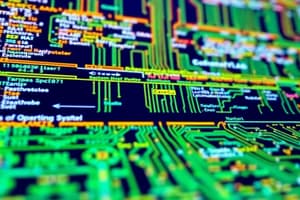Podcast
Questions and Answers
What is the primary function of the kernel in an operating system?
What is the primary function of the kernel in an operating system?
- To manage file systems
- To provide security features
- To manage hardware resources (correct)
- To provide user interface
Which type of operating system is designed for applications requiring predictable, fast responses?
Which type of operating system is designed for applications requiring predictable, fast responses?
- Desktop Operating Systems
- Server Operating Systems
- Mobile Operating Systems
- Real-Time Operating Systems (correct)
What is the main function of device drivers in an operating system?
What is the main function of device drivers in an operating system?
- To interact with hardware devices (correct)
- To provide security features
- To manage file systems
- To manage memory allocation
Which operating system is exclusive to Mac computers?
Which operating system is exclusive to Mac computers?
What is the primary function of process management in an operating system?
What is the primary function of process management in an operating system?
What is the main function of system utilities in an operating system?
What is the main function of system utilities in an operating system?
Which of the following is an example of a server operating system?
Which of the following is an example of a server operating system?
What is the main function of memory management in an operating system?
What is the main function of memory management in an operating system?
Flashcards are hidden until you start studying
Study Notes
Operating Systems
Definition
- An operating system (OS) is a software that manages computer hardware resources and provides common services to computer programs.
- Acts as an intermediary between computer hardware and user-level applications.
Functions
- Process Management: manages creation, execution, and termination of processes (programs).
- Memory Management: allocates and deallocates memory for running programs.
- File System Management: provides access to file systems, allowing programs to read and write files.
- Input/Output (I/O) Management: manages input/output operations between devices and programs.
- Security: enforces access control, authentication, and authorization mechanisms.
- Networking: manages communication between computers and devices.
Types of Operating Systems
- Desktop Operating Systems:
- Examples: Windows, macOS, Linux
- Designed for single-user, single-tasking environments
- Mobile Operating Systems:
- Examples: Android, iOS
- Designed for mobile devices, touch-based interfaces
- Server Operating Systems:
- Examples: Windows Server, Linux distributions
- Designed for multi-user, multi-tasking environments
- Real-Time Operating Systems:
- Examples: VxWorks, QNX
- Designed for applications requiring predictable, fast responses
Key Operating System Components
- Kernel: the core of the OS, responsible for managing hardware resources
- Device Drivers: software components that interact with hardware devices
- System Libraries: pre-built libraries of code that provide common functions
- System Utilities: programs that perform maintenance and management tasks
Popular Operating Systems
- Windows: developed by Microsoft, widely used on desktop and laptop computers
- macOS: developed by Apple, exclusive to Mac computers
- Linux: open-source, widely used on servers, desktops, and mobile devices
Operating Systems
Definition and Functions
- Manages computer hardware resources and provides common services to computer programs
- Acts as an intermediary between computer hardware and user-level applications
- Performs five key functions:
- Process Management: creates, executes, and terminates processes (programs)
- Memory Management: allocates and deallocates memory for running programs
- File System Management: provides access to file systems, allowing programs to read and write files
- Input/Output (I/O) Management: manages input/output operations between devices and programs
- Security: enforces access control, authentication, and authorization mechanisms
- Networking: manages communication between computers and devices
Classification of Operating Systems
Desktop Operating Systems
- Designed for single-user, single-tasking environments
- Examples: Windows, macOS, Linux
Mobile Operating Systems
- Designed for mobile devices, touch-based interfaces
- Examples: Android, iOS
Server Operating Systems
- Designed for multi-user, multi-tasking environments
- Examples: Windows Server, Linux distributions
Real-Time Operating Systems
- Designed for applications requiring predictable, fast responses
- Examples: VxWorks, QNX
Key Operating System Components
Kernel
- The core of the OS, responsible for managing hardware resources
Device Drivers
- Software components that interact with hardware devices
System Libraries
- Pre-built libraries of code that provide common functions
System Utilities
- Programs that perform maintenance and management tasks
Popular Operating Systems
Windows
- Developed by Microsoft, widely used on desktop and laptop computers
macOS
- Developed by Apple, exclusive to Mac computers
Linux
- Open-source, widely used on servers, desktops, and mobile devices
Studying That Suits You
Use AI to generate personalized quizzes and flashcards to suit your learning preferences.




